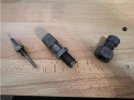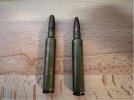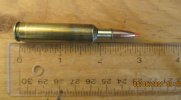responding
My desired ammo count for frequently used rifles, including the 6mm AI is
200 rounds or 4 plastic boxes of 50.
Upon completion of my nice 6mm AI brass I load ammo using Redding F/L 6mm AI size die without expander on turned necks, Lee (inexpensive) 6mm Rem collet dies to size my turned necks (.268 diameter), either Hornady 6mm seat or Lee 6mm Rem seat die and Lee (inexpensive) 6mm Rem factory crimp die to crimp bullets in AI cases. I anneal cases after fire forming and then every 5 rounds. This should also work for .22-.250AI, .280 AI & others.
View attachment 452008
Barrel life is to be considered. Assuming a 1500 round premium barrel life for the 6mm AI, firing 200 bullets when forming cases would be 200/1500 or 13% of barrel life spent on fireforming with substandard ballistics assuming an AI round was desired to improve ballistic performance.
Bullet costs - 100 Hornady SPBT bullets cost between $25-$30 per hundred - 200 bullets needed, $50 - $60. Among the cheapest 6mm bullet.
Powder costs - the cheapest suitable bullet fireforming powder at my LGS without hazmat would run $32.00 per 7000 grains/pound (RS Hunter), a fireform load would use 40-43 grains of Hunter or 175 - 163 bullet fire forms per pound of the cheapest powder available, another pound purchase would be needed to complete 200 round bullet fire forming.
Primers!!! Large rifle primers are real pricey & difficult to find. Assuming $125 per thou, 200 rounds would be $25 - provided they are available at $125 without hazmat costs. With hazmat/shipping added go for $140 + $50 = $190/1000 or 200 * $0.19 = $38
Total cost to fire form with bullets, rifle powder & large rifle primers (including hazmat) = $125 - $137 per 200. This is to be compared with availability of large pistol primers without hazmat, relatively tiny charges of pistol powder, & free dried out used coffee grounds (sun dried or hair drier). We drink Starbuck's coffee - real nice brew with bottled water to avoid corruption of city water via ancient pipes (loaded with iron, calcium & whatever).
Barrel life - using up 13% of a $400 - $500 re-barrel job = $52 - $65. Total costs refreshed = $177 - $202 per 200 rounds bullet fire formed with substandard performance.



